If you want to learn more about how to build a 20×20 gable pavilion plans you have to take a close look over the free plans in the article. This pavilion is built on a sturdy and durable wooden structure and it features a gable roof with a 6:12 pitch. Make sure you read the local codes, so you can comply with the legal requirements. You should also check out the rest of my pavilion plans, because I have many designs you can inspire from.
You need to know that all my plans come with a complete Cut and Shopping lists, so you waste no time and go right ahead and build the garden pavilion. In addition, my 3D diagrams and step by step instructions will make the assembly of the shelter easy.
If you want to get the job done in a professional manner, we recommend you to plan everything with attention, as to prevent costly mistakes and to build a professional garden project. Invest in high quality materials, such as cedar, pine or redwood, as the structure will be exposed to all kinds of weather. Apply a few coats of paint over the components, to enhance their appearance and to protect them from bad weather.
20×20 Gable Pavilion – Free DIY Plans
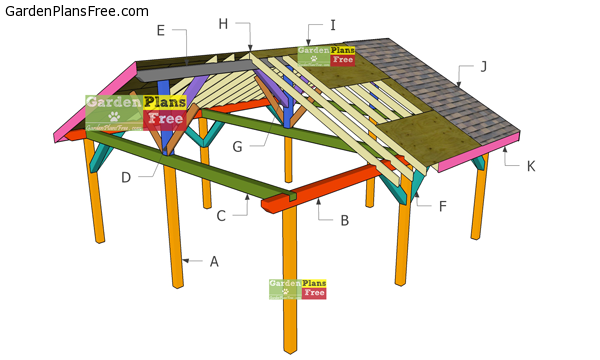
Building-a-20×20-pavilion
Materials
- A – Posts – 6×6 lumber 8′ long 8 pieces
- B – Plates – 6×8 lumber 136″ long 4 pieces
- C – Plates – 6×8 lumber 20′ long 3 pieces
- D – Supports – 6×6 lumber 51 1/2″ long 3 pieces
- E – Ridge Beam – 6×8 lumber 136″ long 2 pieces
- F – Braces – 6×6 lumber 42 1/2″ long 14 pieces
- G – Braces – 6×6 lumber 48″ long 4 pieces
- H – Rafters – 2×6 lumber 156′ long 36 pieces
- I – Roof – 1/2″ plywood 4’x8′ 12 pieces
- I – Roof – 1/2″ plywood 4’x4′ 4 pieces
- I – Roof – 1/2″ plywood 4’x80″ 2 pieces
- I – Roof – 1/2″ plywood 32″x4′ 4 pieces
- I – Roof – 1/2″ plywood 9 1/2″x96″ 4 pieces
- I – Roof – 1/2″ plywood 9 1/2″x80″ 2 pieces
- K – Trims – 1×8 lumber 157 3/4″ long 4 pieces
- K – Trims – 1×8 lumber 128″ long 2 pieces
- K – Trims – 1×8 lumber 144″ long 2 pieces
- L – Decorative Elements – 2×6 lumber 53 1/2″ long 6 pieces
- 9 pieces of 6×6 lumber – 8′ long
- 7 pieces of 6×6 lumber – 10′ long
- 1 piece of 6×6 lumber – 12′ long
- 6 pieces of 6×8 lumber – 12′ long
- 3 pieces of 6×8 lumber – 20′ long
- 3 pieces of 2×6 lumber – 10′ long
- 36 pieces of 2×6 lumber – 14′ long
- 4 pieces of 1×8 lumber – 12′ long
- 4 pieces of 1×8 lumber – 14′ long
- 19 pieces of 1/2″ plywood – 4’x8′
- 630 sq ft of Tar Paper & Asphalt Shingles
- 8 pieces of 6×6 Post Anchors
- 8 pieces of 16″ diameter tube form
- several concrete bags
- 6 pieces Post to Beam Connector
- 800 pieces of 1 5/8″ screws
- 12 pieces of 8″ screws
- 12 pieces of 10″ screws
- 2″ nails
- 75 pieces of 5 1/2″ screws
- 72 rafter ties
- 2 boxes of 1 1/2″ structural screws
- 1 box of 2 1/2″ structural screws
- 100 ft of drip edge
- 8 post anchors
- wood glue, stain/paint
Tools
- Hammer, Tape measure, Carpentry square
- Miter saw, Drill machinery, Screwdriver, Sander, Router
- Safety Gloves, Safety Glasses, Respiratory Mask
Time
- One week
Step 1: Building the Base of the Pavilion
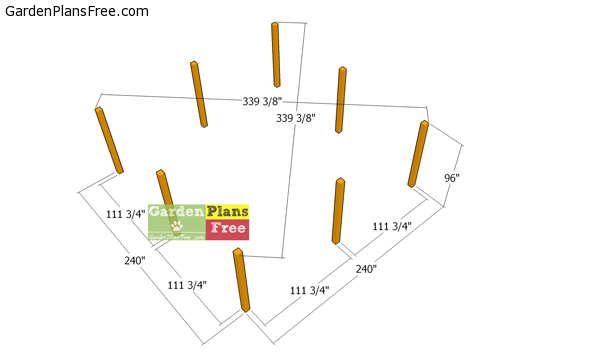
Laying-out-the-posts
First, layout the posts for the 20×20 pavilion. Use batter boards and string to determine the location of the posts. Apply the 3-4-5 rule to every corner of the pavilion, so you make sure they are right angled.
Also, make sure the diagonals are equal. Determining the location for the pavilion is essential, as you have to comply with the local building codes. Make sure the surface is level and remove the vegetation layer.
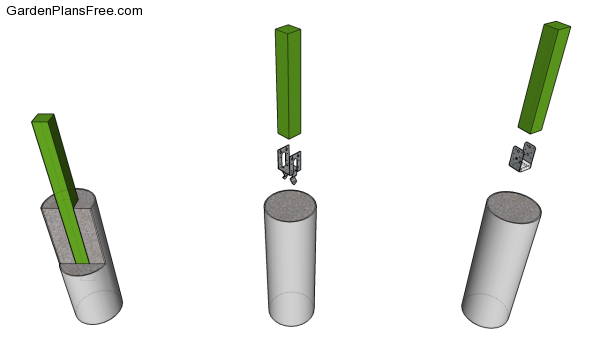
Next, dig 3 ft holes into the ground, making sure they have about 16″ in diameter. Fit the tubes then the posts into the ground and plumb them with a spirit level. Use temporarily braces to make sure the posts are locked into placed while filling the holes with concrete. Let the concrete dry out for several days. Read the local codes for more details on how to secure the posts.
Furthermore, use lag screws to secure the posts to the anchors. Before pouring the concrete you need to make sure the top of the posts are horizontal one to another. Use a laser to mark the level to the top of the posts and use a circular saw, if you need to make cuts.
Step 2: Attaching the top plates
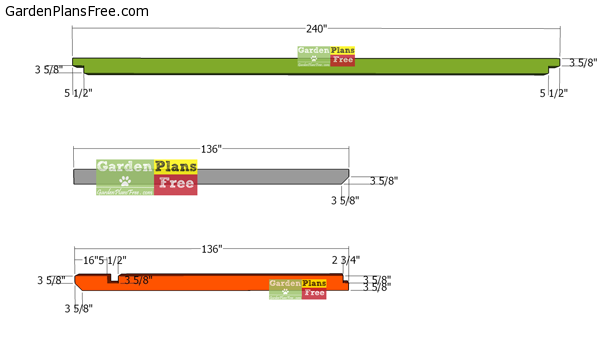
Top-plates-for-20×20-pavilion
I suggest you use 6×8 lumber for the top rails and for the ridge beams. Mark the cut lines on the beams and then make the cut outs with a circular saw and a chisel. Set the circular saw at 3 5/8″ and then make parallel cuts inside the marked areas. Also, clean the recess with a chisel and sandpaper.
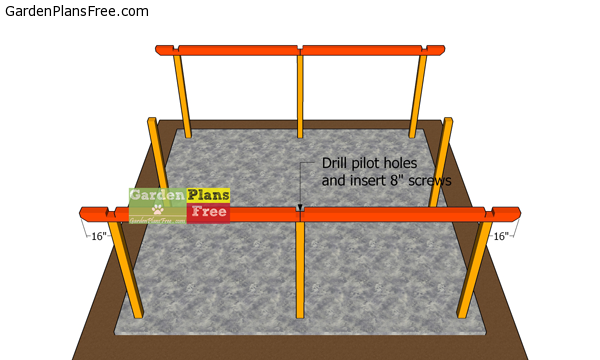
Fitting-the-side-plates
Fit the top rails to the sides of the pavilion. Notice the 16″ overhangs to the front and back of the pavilion. Drill pilot holes through the plates and insert 8″ screws to lock them to the posts.
In addition, use 2 screws for each joint. Make sure the corners are square and plumb the posts vertically.
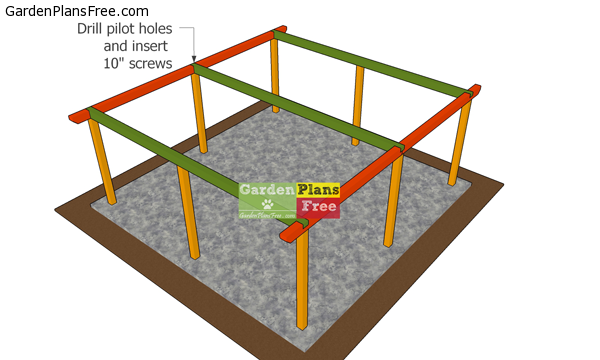
Fitting-the-cross-beams
Fit the cross plates to the pavilion. Align the edges flush and drill pilot holes. Insert the 10″ screws to lock the cross plates into place tightly. If you need plans for an even larger pavilion, take a look over these 20×30 pavilion plans.
Step 3: Fitting the braces
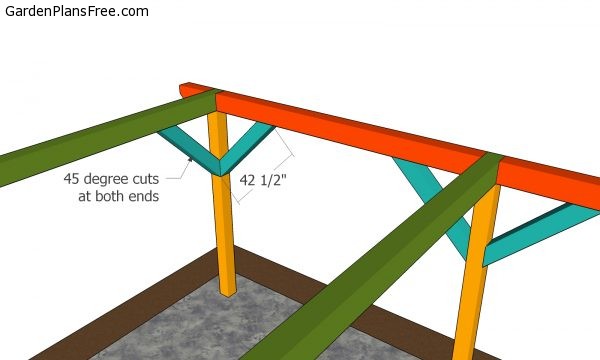
Braces for pavilion
Continue the outdoor shelter project, by building the braces for the base of the pavilion from 6×6 lumber. Use a miter saw to make 45 degree cuts to both ends of the braces. Fit the braces to the posts, after you plumb them vertically. Drill pilot holes and insert 5 1/2″ screws to secure the braces into place tightly (2 for each joint).
Step 4: Building the Roof of the Pavilion
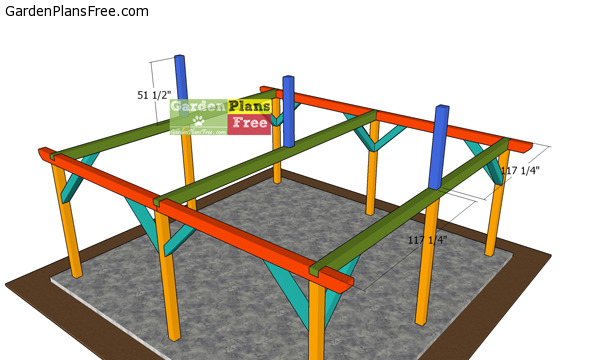
Ridge-beam-supports
Also, center the 6×6 supports to the top of pavilion. Plumb the supports with a spirit level. Use post to beam connectors to secure the supports to the frame of the pavilion.

Fitting-the-ridge-beams
Next, fit the ridge beam to the supports with post to beam connectors. Make sure the corners are square. Use 2 1/2″ structural screws to lock the connectors into place.
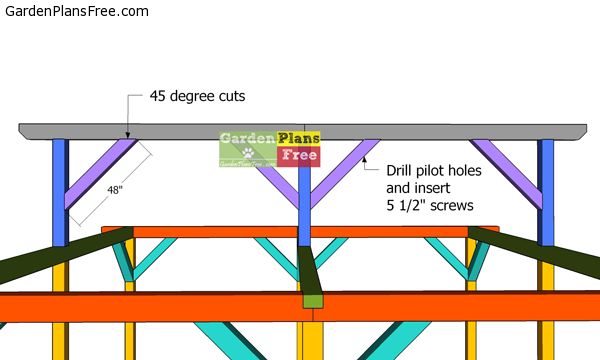
Fitting-the-braces-to-the-ridge-beam
Use 6×6 lumber for the braces. Make 45 degree cuts at both ends of the braces. Secure the braces into place with 5 1/2″ screws. Drill pilot holes before inserting the screws,
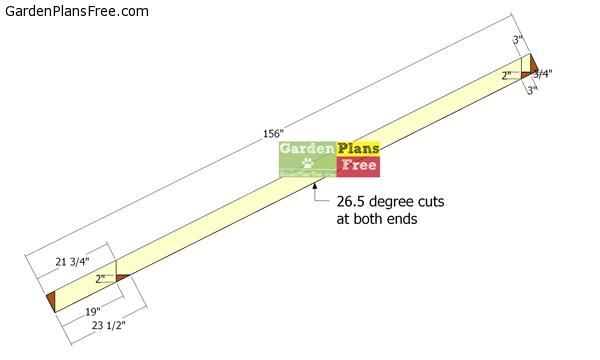
Rafters—large-pavilion
Furthermore, use 2×6 lumber for the rafters. Use a miter saw to make the cuts to the boards. Smooth the edges with sandpaper. Make the notches to the rafters, as shown in the plans. Mark the lines before doing the cuts.
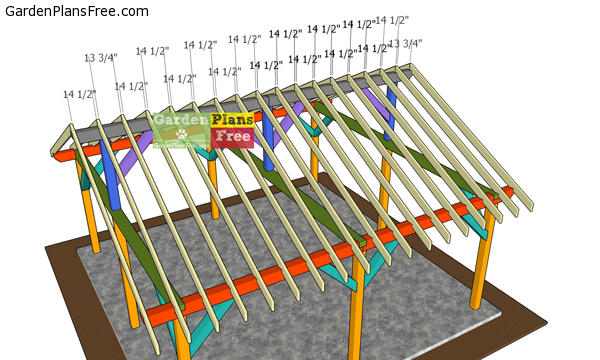
Fitting-the-rafters
Fit the rafters to the top of the pavilion, using the information from the diagram. It is important to space the rafters properly (every 16″ on center), otherwise you won’t be able to attach the roofing sheets. Use rafters ties to lock the rafters to the beams. Use 1 1/2″ structural screws for the rafter ties.
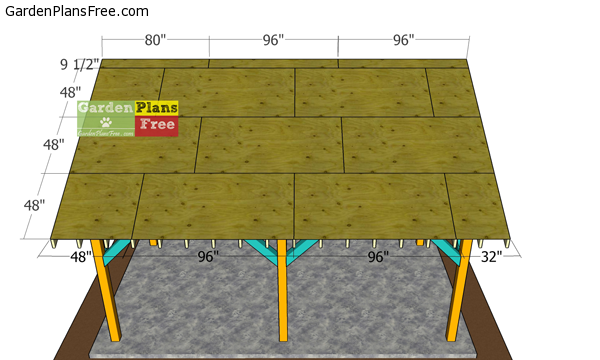
Fitting-the-roof-sheets
I suggest, you use 1/2″ plywood for the roof of the pavilion. Cut the sheets at the right dimensions and then lay them to the top of the pavilion. Leave no gaps between the sheets and then insert 1 5/8″ screws, every 8″ along the rafters, so you can secure them into place tightly.
Step 5: Pavilion Finishing Touches
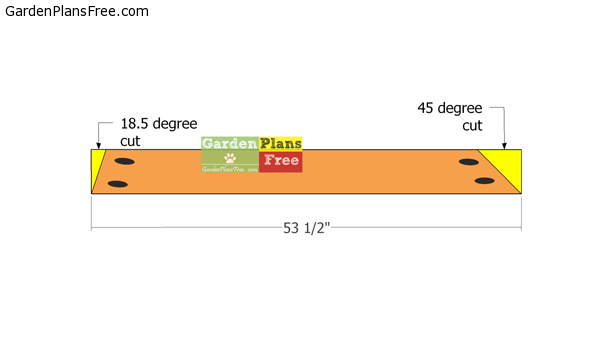
Diagonal-trims—gable-ends
Use 2×6 lumber for the diagonal elements. You need a miter saw to make the angle cuts as shown in the diagram. Drill pocket holes at both ends of the components.

Fitting-the-diagonal-trims
In addition, fit the elements to the three support beams and lock them into place with 2 1/2″ screws. Make sure you place the pocket holes oriented towards the inside, for a nice finish. I show them oriented towards the outside just to be clear on how they are connected to the pavilion frame.
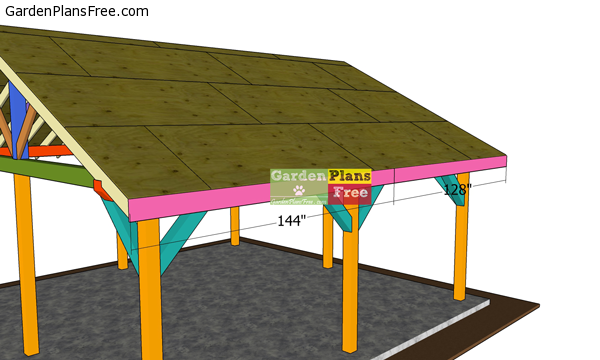
Side-trims—large-pavilion
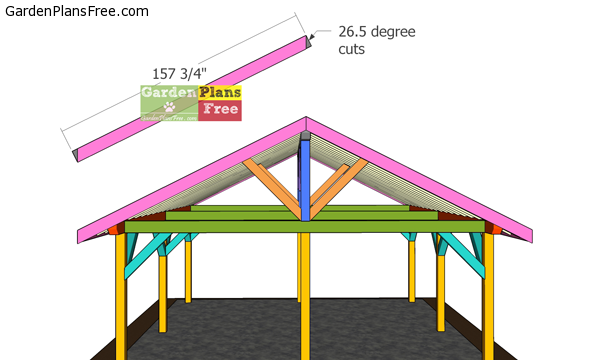
Gable-end-trims
Fit 1×8 trims to the sides of the pavilion. Align the edges with attention and insert 2″ nails to lock them into place tightly. Also, fit the 1×8 trims to the front and back of the pavilion. Lock them into place with 2″ nails.
Step 6: Finishing touches
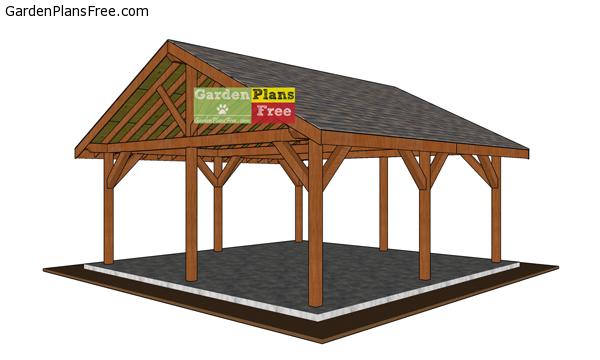
16×24-gable-pavilion-plans
Cover the roof with tar paper and then install the asphalt shingles. Make sure you also install the appropriate drip edges, so you can seal the shed roof. Read the manufacturer’s instructions for a tight fit.
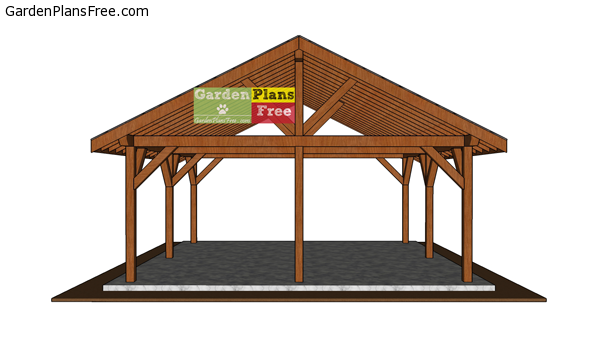
20×20-pavilion-plans—free-diy-plans
Last but not least, you need to take care of the finishing touches. Therefore, fill the holes with wood putty and then smooth the surface with 120-220 grit sandpaper.
Apply a few coats of paint / stain to enhance the look of the pavilion and to protect them from the elements.
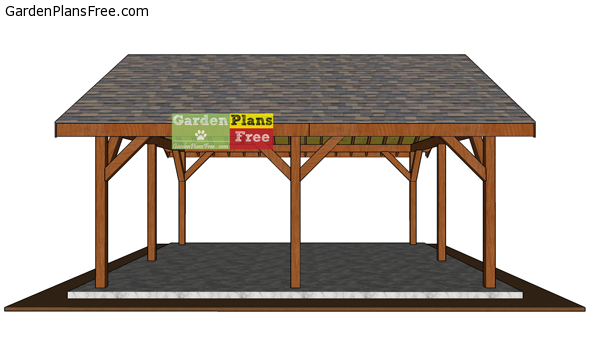
20×20-Pavilion-Plans-side-view
This large pavilion is easy to make and it will shelter a nice relaxation are for you and the loved ones. The structure of the pavilion is sturdy. You can play with the pitch of the roof, that is in my designs 6:12.
PRO TIP: Apply several coats of paint or stain over the components, in order to protect them from decay. Check out the rest of the project to learn more about building garden projects. I also have free plans for you to build a 14×14 lean to pavilion, so you should consider checking them out, as well. You can also take a look over these free plans for a 16×20 lean to pavilion.


5 comments
These are Great for our plans to build a Pavilion (we actually are planning on a 16 x 20). But is there a way to print them? You have it such that right-click/print doesn’t work, and I don’t see a Print button anywhere. I’ll be happy to send photos of the finished article.
I added a download button.
Is it possible to build this in a 16×20 configuration so that the front of the structure is 20 feet wide and 16 feet deep. Also, with a 16ft span could two of the posts be eliminated? The only 16×20 pavilion plans I see have the roof in the wrong direction for my layout.
Hi Thomas, can we change the F-Brace by metal square in the angle?
Thank you, you plan is amazing.
Hello thomas last week i thought I paid and downloaded a gazebo plan, would you check and are you available to make revisions for additional charges , your 14X14 open gable pavillion or porch cover is what i am looking for However I have a deck 20 x 10 so i need to have long gable end at 20